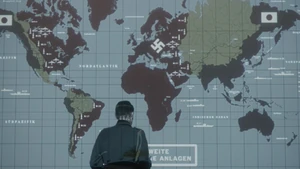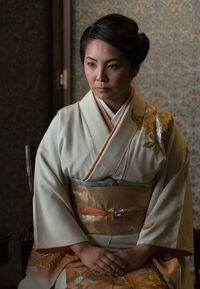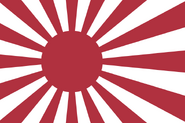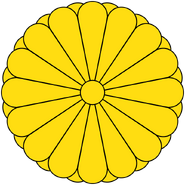|
Japanese Empire | ||||
| Dai Nippon Teikoku | ||||

|

| |||
| Motto The Oath in Five Articles | ||||
| Anthem "Kimigayo"
| ||||
| ||||
| Capital | Tokyo | |||
| Government | Unitary parliamentary semi-constitutional monarchy under under a Shōwa Statist system | |||
| Emperor of Japan | Hirohito | |||
| History | ||||
| - January 3, 1868 | Meiji Restoration | |||
| Population | 105 million (1940) | |||
| Currency | Japanese Yen | |||
| Official Language | Japanese (Lingua Franca) | |||
| Military | Imperial Japanese Army
| |||
| Police | Kempeitai | |||
|
| ||||
The Japanese Empire, or Empire of Japan (大日本帝國 Dai Nippon Teikoku - literally "Greater Japanese Empire") is one of the two superpowers in the world of The Man in the High Castle along with the Greater Nazi Reich. The two powers are in a state of Cold War with Japan in a disadvantaged position due to a technological divide. Under the Japanese military and the Imperial Rule Assistance Association, Japan has become a Unitary parliamentary semi-constitutional monarchy under under a Shōwa Statist one-party authoritarian-totalitarian military dictatorship.
History[]
Assuming the rise of the Japanese Empire is similar to our world's, the empire's seeds began on March 31, 1854 with the Convention of Kanagawa. Where Commodore Matthew Perry of the United States Navy forced the opening of Japan after 220 years of national seclusion (鎖国 Sakoku). The following years would bring similar (and unequal) treaties with other Western countries and lead to political and economic turmoil. This turmoil would eventually see the collapse of the Tokugawa Shogunate and restoration of Imperial rule in 1868 under Emperor Meiji (明治維新 Meiji Ishin).
In the Meiji Era, Imperial factions resolved to modernize feudal Japan into a power that could rival those in the West (富国強兵 Fukoku kyōhei, "Enrich the state, strengthen the military"). After rapid industrialization and the modernizing of both its military and infrastructure, Japan began looking outward to expand its influence. The Japanese Home Islands were bereft of many raw materials and resources necessary to sustain modern industry, and so the Imperial government saw military expansionism as vital to the Empire's survival.
Now an industrial power, Japan moved to dominate its Asian neighbors. The Empire crushed China in the First Sino-Japanese War in 1895, acquiring the Liaodong peninsula and Taiwan. Finally, and most impressively, Japan defeated the Russian Empire in the Russo-Japanese War in 1905. securing Liaodong and Korea, (later annexing it in 1910) as well as opening up the region of Manchuria to Japanese influence. Notably, this war marked the first time a modern, industrial European nation was defeated in a war by a non-European power.
Emperor Meiji died in 1912 and was succeeded by his son the Crown Prince as Emperor Taishō (大正天皇 Taishō-tennō). During World War I, the Empire aligned with the Allied Powers and declared war on Germany as an opportunity to grab more territory, acquiring the Marianas, the Caroline and Marshall Islands, and the Shandong province of China (German controlled). When the war was won, the Empire demanded a "Racial Equality Clause" in the Treaty of Versailles (with the implicit notion that the West view the Japanese as racially equal), this demand was outright rejected by a number of Allied Powers. This rejection played an important part in the Empire's souring of relations with the West and its reconciliation to Germany after the war.
Taisho died in 1926 and like his father before him was succeeded by the Crown Prince, who became the new Emperor, Shōwa (昭和時代 Shōwa Jidai). Conservative factions within the Imperial government grew ever stronger and more radicalized. Nationalism (always present within the Empire's history) intensified into Kokutai, which at this time, symbolized the ideal that Japan and its people were altogether superior to all other nations on Earth. The military's power grew as well, it effectively deposed civilian Government in 1932 and while there was the official pretense of the Emperor in control, the true power lied with the Generals and Admirals of the Imperial Army and Navy, a situation ironically similar to that of a Shogunate.
As Hitler rose to power in Europe, the Japanese were already at war in Asia, seizing Manchuria and transforming into a puppet state, Manchukuo in 1931, then launching a full-scale invasion of China in 1937. Eventally the Japanese Empire allied with Hitler's Reich and they formed the "Axis." During World War II, the Japanese conquered most of Eastern Asia, Australia, British India, etc, with all becoming Japanese Puppet States. Japan used its influence to turn Pakistan into a sovereign republic. This is because Japan didn't want it's empire to share it's borders with the Reich. Germany and Japan divided the world amongst themselves, and eventually together they won World War II. In 1945, the Japanese succeeded in conquering the Western United States, Western Canada, and the Baja Peninsula of Mexico. All of these territories were in turn incorporated and annexed into the Japanese Pacific States.
By 1964, the Japanese were facing multiple rebellions against their totalitarian rule in China, Australia, India, and the Japanese Pacific States. It is also mentioned that the Chinese forces successfully managed to liberate both Korea and Manchuria from the Japanese Empire's rule. Unable to contain the rebellion in the Japanese Pacific States, the Emperor announced the dissolution of the Japanese Pacific States and the withdrawal of Japanese Forces from the territory the same year, with forces instead being redirected to the war in China. When the Japanese withdrew from the Pacific States, the Black Communist Rebellion took control of the former Japanese Pacific States territories. The Black Communist Rebellion turned the former territory into a new independent country, called the Western States.
Overview[]
Territory[]

The series does not leave much information about the actual territorial extent of the Japanese Empire, in Fritz Julius Kuhn High School is briefly shown with Japanese territories marked in blue. According to this map, The Japanese control the entire Pacific Ocean, Korea, Sakhalin, Southeast Asia, The East Indies, India, Nepal, Bhutan, Bangladesh, Eastern and Southwest China, Eastern Siberia, Ecuador, Chile, Peru, Baja California, the whole Australian Continent, the North American West Coast, and the South American West Coast.
The Japanese have seem to lost their territories in Mengjiang and Central China due to rebellion.
After World War II, parts of China, Manchuria, Burma, Vietnam, Laos, Kampuchea, The Philippines, Indonesia, Malaysia and other countries were possibly made self-governing puppet states, within the Japanese Empire.
Flags and Emblems[]
The official flag of the Japanese Empire, in 1962, is still the Hinomaru, the original civil and state flag of Japan from 1870 to 1962 (a flag with a red sun-disc centered on a white field). However, by 1962, the series shows the flag, in numerous public and official manifestations, as having been largely substituted with the Kyokujitsu-ki (the Rising Sun Flag) which served, since 1889, as naval and army (with slightly variations) ensign of the Japanese Armed Forces, and it's a clear sign and evidence of the militaristic public life of the Japanese Empire and of its policies. The flag is a white field with a red disc slightly to the hoist with 16 rays extending from the disc to the edges of the flag.
Politics and Policies[]

Akihito, the Crown Prince of Japan

Michiko Shōda, the Crown Princess of Japan
The capital of the Japanese Empire is Tokyo, which has been the capital of Japan since 1869. Although Tokyo has yet to be shown, it is mentioned as the center of economic and political relations of the Greater Co-Prosperity Sphere and therefore the Japanese Bloc. The Japanese imperial government is described as a typical military oriented government, which still officially has the Emperor of Japan, as Head of State, despite him not having any serious political power. The monarchy does not have extensive rule, leaving the government to the military. This however, seems to have created some issues between the Japanese military and the Emperor's Court about the general policies that the Empire must take for the future, especially in regards to their rival superpower, the Greater Nazi Reich, which has a clear advantage over the Japanese Empire, in both technological and scientific development, having created the Heisenberg Device (a nuclear bomb), supersonic jet airliners and even rocket ships. The main divide on the foreign policy towards Germany, is to either take a more aggressive position with the Greater Nazi Reich or continue a policy of "peace and balance".
On the international stage, Japan is the leading nation of the Japanese Imperial bloc, though it seems to be carrying out a more indirect method of control through membership of the Greater Co-Prosperity Sphere. Though formally independent, the Imperial Japanese Army and even the Kempeitai seem to be able to operate with impunity in member nations, and the Japanese government consider these countries little more than colonies. The nations that are known to be members of the Greater Co-Prosperity Sphere are: Manchuria, Inner Mongolia, China, Tibet, Bhutan, Nepal, India, Burma, Vietnam, Laos, Cambodia, Indonesia, the Philippines, Australia, New Zealand, the Japanese Pacific States, Peru, Ecuador, and Chile. One last aspect of the Japanese Empire, on the domestic stage, is that in the Japanese Empire, the Yakuza (the most powerful Japanese criminal organizations) has grown relatively stronger than in our timeline, allowing them to be an effective anti-state force. Whilst the Japanese do not pursue a Final Solution-like policy towards non-Japanese and tolerate their existence, they enforce laws and policies that favor the Japanese, with their culture being deemed "superior". This obviously caused immense discontent among their subjects and the Japanese undertake great efforts to ruthlessly suppress anyone that rebels.
Japan is a de jure Unitary Semi-Constitutional Monarchy, while de facto it is a Shōwa Statist one-party Authoritarian-Totalitarian Military Dictatorship nominally under Emperor Hirohito.
Economics and Technology[]

Yen is the currency of the Japanese Empire.
The economy of the Japanese Empire is quite prosperous and with the establishment and expansion of the Greater Co-Prosperity Sphere, the Japanese were able to reaffirm their economic positions with the rest of the world. However, most of the wealth in the empire is concentrated in the ethnic Japanese upper class. The Japanese Empire and all other countries of the Greater Co-Prosperity Sphere use the Japanese Yen as currency. No other information is given about the economy of the Japanese Empire, but it is likely that it rivals that of the Greater Nazi Reich and is one of the largest in the world.
Japanese scientific development lags significantly behind that of the Greater Nazi Reich, which is a great cause for concern for the empire's leaders.
Modern automatic firearms such as the Type 37 battle rifle (the in-universe equivalent of the real life Howa Type 64) were shown to be in use by Japanese Imperial Guards during the speech by Crown Prince Akihito (that appear to predate in this world their development in our own. However, throughout the series; WWII-vintage Japanese small arms like the Type 38 'Arisaka' bolt-action rifle and the Type 14 'Nambu' pistol were still used by Kempeitai soldiers and officers in the Japanese Pacific States and, quite possibly; the Imperial Japanese Army in the rest of the states).
It was not possible for the Japanese to replicate the Heisenberg Device until Kotomichi accidentally obtained the schematics to build the device. The Japanese began an atomic weapons program of their own in San Francisco but had yet to produce a functioning atomic bomb by early 1962, which meant the Greater Nazi Reich held a decisive military advantage as tensions between the two nations intensified. World War III was only avoided because the Nazis came to believe the Japanese possessed their own atomic arsenal plus a stockpile of Hydrogen Bombs. The Japanese successfully detonated their first atomic bomb at Monument Valley, Utah in Fall 1962, but feared that the Germans would deduce from the test bomb's explosion that they had yet to develop a Hydrogen Bomb.
In Fall of 1962, the Japanese Empire was plunged into a severe oil crisis brought on by an undeclared embargo carried out by the Greater Nazi Reich. Trade Minister Tagomi was responsible for overseeing a project intended to create synthetic oil with the help of Nazi scientists who had defected from the GNR. With the production of synthetic oil underway and the oil embargo lifted by the GNR, the oil crisis is temporarily over for the Japanese Empire.
Notable Locations[]
Tokyo[]
Tokyo has served as the Japanese capital since 1869, and since the end of the war, it has ruled over the Japanese Empire and it's multiple conquered territories throughout the Pacific. San Francisco serves as the capital of the Japanese Pacific States in North America, under the direct leadership of Tokyo.
Nagasaki[]
Nagasaki is a city located on the island of Kyushu in the Japanese Empire. Nobusuke Tagomi's trusted aide, Kotomichi, and his family are from this city. Tagomi once commented that Nagasaki was a "beautiful city".
In the real timeline, this city was destroyed by a nuclear device dropped by The Allied Powers. Kotomichi was injured in this blast, and as he sought meditation to help him with the pain of his burns, he learned how to travel parallel worlds, and sought refuge in one in which the Axis powers won the war.
Notes & Trivia[]
Divergences with Our World[]
- Grand Admiral Isoroku Yamamoto was responsible for creating flag of the Japanese Pacific States in 1945, and resided in the country until his death. In our world, Yamamoto died in 1943, when American code breakers identified his flight plans and his plane was shot down and his death was a major blow to Japanese military morale during World War II in our timeline. The cover story for this was that Yamamoto succumbed to injuries in a failed Allied assassination attempt. Yamamoto was among few Axis commanders, others included Erwin Rommel and Reinhard Heydrich, who were directly targeted for assassination by Allied planners.



